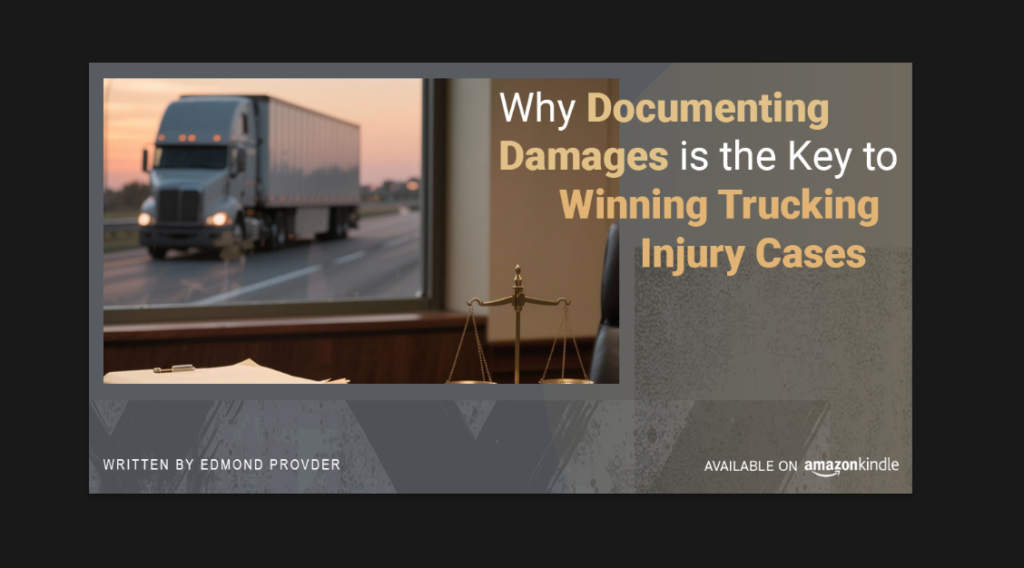Trucking accidents are unlike any other type of personal injury case. They are often devastating, both physically and financially, and the damages go far beyond immediate medical bills. Victims face long-term rehabilitation, loss of income, diminished earning capacity, and a lifetime of care needs. For attorneys handling these cases, proving liability is only half the battle. The other half—often the deciding factor between a modest settlement and a life-changing verdict—is documenting damages effectively.
This is the central message of Edmond Alan Provder’s A Comprehensive Guide to Documenting Damages in Trucking Injury Cases, a book that distills more than five decades of expertise into a practical resource for lawyers, vocational experts, and life care planners.
Why Damages Documentation Matters
In any trucking injury case, damages are the story of impact. They illustrate not only what happened to the victim but also how that injury reshaped their ability to live, work, and thrive. Without detailed documentation, damage risk is reduced to speculation—a problem that insurance companies are quick to exploit.
Provder emphasizes that damages must be measurable, defensible, and human. It is not enough to claim that an injured person can no longer work at their former job. Attorneys must be able to demonstrate how the injury affects vocational capacity, earning potential, household contributions, and future medical needs. This requires careful coordination of experts and data.
The “House of Damages” Approach
One of Provder’s most valuable contributions is his “House of Damages” framework. Just as a house is built on a foundation with walls and a roof, damage documentation requires structure and interconnection. Vocational assessments, life care plans, and economic analyses cannot exist in isolation. They must work together as parts of a cohesive whole.
- The Foundation: Vocational experts determine what kind of work, if any, the injured person can perform post-accident.
- The Walls: Life care planners identify medical, rehabilitative, and support needs across the individual’s lifetime.
- The Roof: Economists translate these needs into dollars, presenting the financial implications in a way judges and juries can understand.
This framework not only clarifies the role of each expert but also ensures their findings reinforce each other. When built properly, the “House of Damages” is nearly impossible to dismantle in court.
From Complex Data to Human Impact
Another challenge attorneys face is translating technical data into narratives that resonate with juries. Provder’s book shows how to bridge this gap. By humanizing numbers—showing how the loss of vocational ability affects not just income but dignity, or how a life care plan preserves quality of life—attorneys can make damages real and compelling.
For example, documenting that an injured client can no longer cook meals for their family or mow their lawn may seem minor compared to lost wages. But these details paint a fuller picture of loss, one that jurors can empathize with and attorneys can use to strengthen their arguments.
A Guide Rooted in Experience
What sets this book apart is its grounding in decades of practice. As a Certified Rehabilitation Counselor and Life Care Planner, Provder has worked on countless cases, collaborating with attorneys to secure fair compensation for clients. His guidance is not theoretical—it is practical, tested, and battle-proven in the courtroom.
The book serves not just as a manual for documentation but as a mentor in print. It teaches attorneys how to think strategically, how to integrate expert testimony, and how to anticipate the tactics of defense counsel who often attempt to minimize damages.
Conclusion: Building Stronger Cases
Trucking injury cases demand more than proving fault—they demand proving impact. By documenting damages thoroughly and cohesively, attorneys not only strengthen their case but also honor the client’s experience.
Edmond Alan Provder’s A Comprehensive Guide to Documenting Damages in Trucking Injury Cases is a timely reminder that justice in these cases is not won through argument alone but through evidence that is clear, credible, and deeply human. For attorneys, vocational experts, and life care planners, it is both a toolkit and a roadmap for turning tragic circumstances into fair and rightful compensation.
Amazon Link: A Comprehensive Guide to Documenting Damages in Trucking Injury Cases



